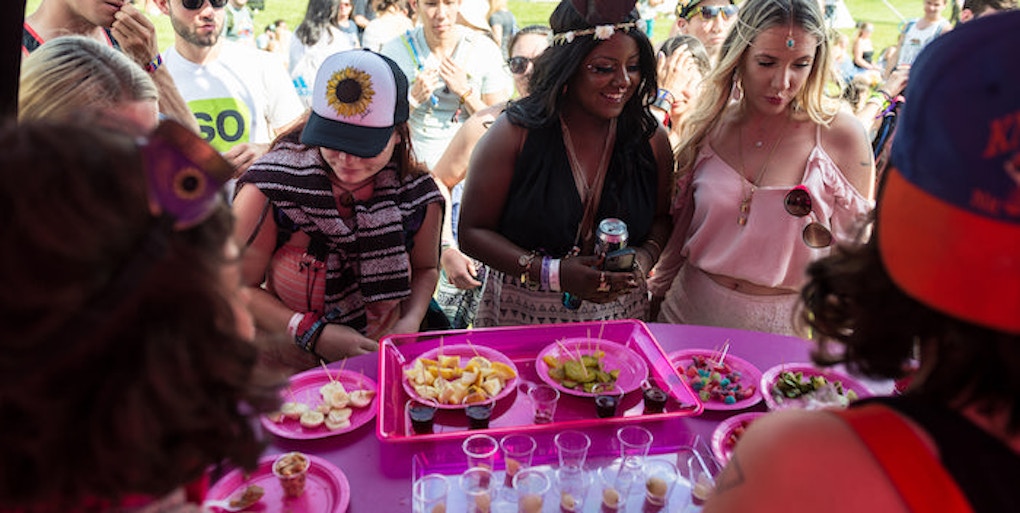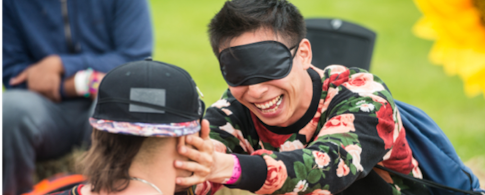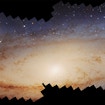Dating in the Dark and Other Unexpected Encounters With Science

BETHEL, N.Y. — At the Mysteryland USA arts, music and culture festival, on the grounds of the original 1969 Woodstock concert, a new generation prepared to take a different kind of trip. Awaiting visitors were sweet lemons, pink-wigged travel agents promising trips across the solar system, and blindfolded ‘dates’ with a few of their fellow campers. The goal was not merely to entertain, but to expand the ways in which people engage with science.
Public science experiments might seem out of place at Mysteryland, now in its third year at Bethel Woods Center for the Arts. The celebration, defined by pulse-pounding electronic dance music and eccentric costumes, attracts mostly college students and 20-somethings looking for a weekend of partying and lighthearted fun. But for Guerilla Science, an organization based in New York City and London that seeks to bring exciting and accessible science experiences to unexpected places, this festival was an opportunity to engage with audiences not traditionally thought of as the ‘science museum’ type.
“"Human beings are scientists from birth, in the sense that we all have a curiosity to explore the world around us and learn from our experiences." — Olivia Koski, Guerilla Science”
“Science is often presented as something that is ‘other,’ that it is for only certain types of people,” says Olivia Koski, operations director for Guerilla Science. “That’s a ridiculous notion. Human beings are scientists from birth, in the sense that we all have a curiosity to explore the world around us and learn from our experiences.” Koski and her colleagues at Guerilla Science have been experimenting with this concept in the U.K. since 2008 with funding from the Wellcome Trust. Last year, they received a three-year grant from the Simons Foundation to bring this approach to diverse audiences in the United States. Past events have included “The Science of Disco,” which provided insight into how our brains behave when we dance, and “The Fire Organ,” featuring a huge, unorthodox pipe organ that uses flames to reveal the shapes of sound waves.
At Mysteryland, participants could play the Fire Organ and participate in the “Flavor Feast,” a series of taste-based experiments designed to disrupt expectations about certain foods. Guerilla Science’s staff provided ‘miracle berry’ pills, derived from a West African fruit that has a compound that binds to taste buds. As a result, adventurous taste trippers found that pickles, lemons and other foods that usually taste sour or acidic now tasted sweet.
Also present was the Intergalactic Travel Bureau, a futuristic ‘travel agency’ selling people on the virtues — and dangers — of trips to the moon, Mars and beyond. The bureau’s pitch included fascinating details of places in the solar system, such as the vast canyons of Mars and the deep ocean of Europa, one of Jupiter’s largest moons. After speaking with an agent, potential travelers could send cleverly designed postcards to loved ones with imagined greetings from these exotic locations.

Perhaps the most popular event was “Sensory Speed Dating,” which enabled potential couples to learn a bit about the science behind attraction. Daters sat blindfolded opposite fellow participants. Typical first-date questions — where did you grow up, or what do you do for work — were absent. Instead, participants smelled each other. Or touched each other’s faces. Or fed each other mystery food from plates in front of them. Each round presented a new sensory experience.
Between rounds, Zarinah Agnew, a longtime collaborator with Guerilla Science and a postdoctoral research associate at the University of California, San Francisco, laid out the science behind each of the senses as they relate to attraction. After participants finished smelling each other, Agnew explained the difference between two odor compounds the body makes. Androstenol, a pheromone found in male sweat, is perceived as attractive by heterosexual females and gay males within the first 15 minutes of perspiration. But the scent of androstenone, produced when older sweat meets oxygen, puts people off (think crowded mass transit on a hot summer day). Interestingly, however, the aversion changes for women when they ovulate — androstenone evokes a neutral reaction rather than an overtly negative one.
Although Guerilla Science stopped short of encouraging volunteers to kiss, Agnew did cite a 2013 study in the journal Archives of Sexual Behavior that suggests kissing may be a ‘mating audition.’ Agnew likens a kiss to a taste test of sorts, enabling would-be partners to see if their immune systems are compatible: Studies have suggested that major histocompatibility complex genes influence body odor and mate selection.
Festivalgoers were certainly intrigued. “It’s a bit awkward at first, being blindfolded, but it’s also hysterical,” said Emma Flanagan, a teacher from Ireland. “It’s pretty interesting learning about yourself in that way.” For Nicki Colandro, a student from Yonkers, N.Y., an unintended consequence may have been a shift in her approach to dating. “I never really thought about the science aspect of dating someone,” she said. “For the next person it doesn’t work out with, I might tell them, ‘I hate your armpits.’”
Their comments don’t sound like typical reactions to an encounter with science, but to Koski, they are familiar. “There is a moment that occurs at a successful event, a ‘eureka’ moment when [participants] put two and two together and realize something new about the world,” she says. “We want to challenge their expectations of science and scientists and provide a stepping-stone to something more. We hope Guerilla Science is a gateway drug, and when they leave they want to learn more about the world around them.” Providing a positive experience with science, especially in places where science events don’t receive top billing, is certainly a worthy first step.


